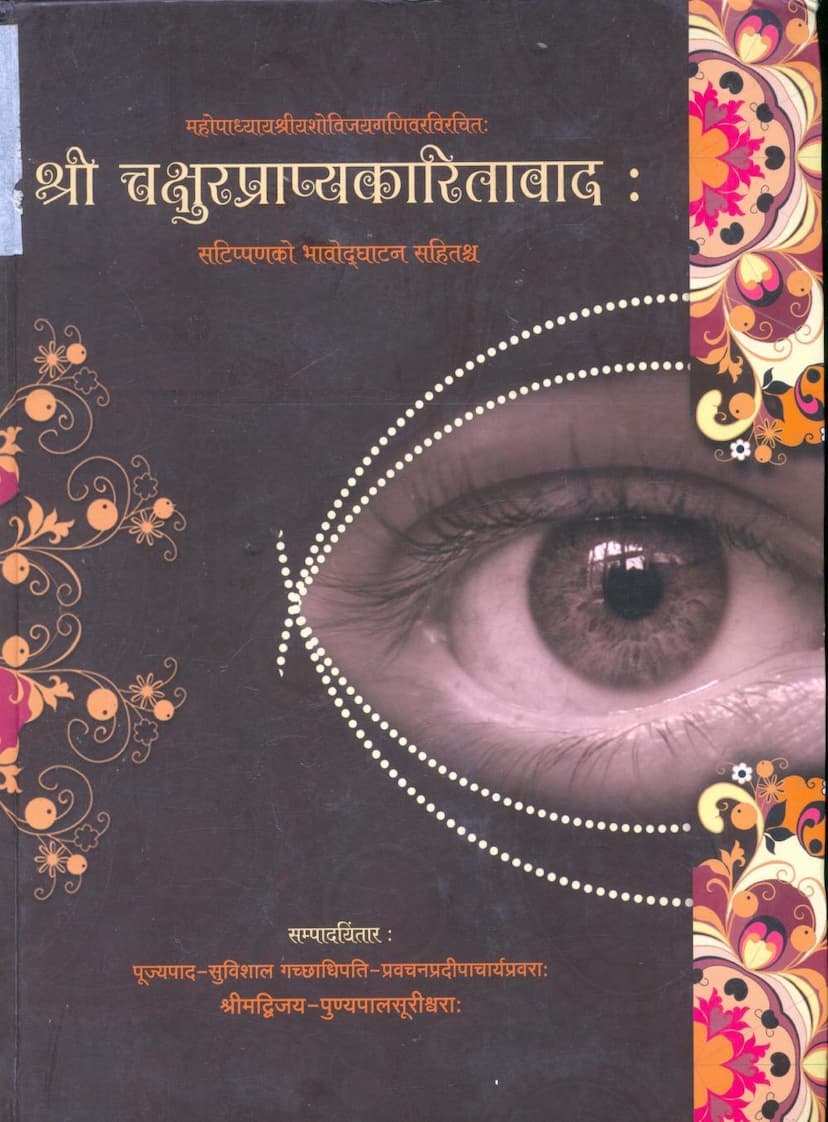Chakshurprapyakaritawad
Added to library: September 1, 2025

Summary
This document is a Gujarati-language publication of a Jain philosophical text titled "Chakshurprapyakaritawad" (चक्षुरप्राप्यकारितावाद). Here's a comprehensive summary based on the provided pages:
Book Title: Chakshurprapyakaritawad (चक्षुरप्राप्यकारितावाद) Author: Mahopadhyaya Shri Yashovijayji Ganivar (महोपाध्याय श्री यशोविजयजी गणिंवर) Publisher: Parshwabhyuday Prakashan, Ahmedabad (पार्श्वोदय प्रकाशन अमदावाद) Editor/Compiler: Pujyapada-Suvishal Gachhadhipati, Pravachanpradipacharya Pravarah, Shrimad Vijay Punyapal Surishwarji Maharaj (पूज्यपाद-सुविशाल गच्छाधिपति-प्रवचनप्रदीपाचार्यप्रवराः। श्रीमद्विजय-पुण्यपालसूरीश्वराः।)
Core Subject Matter:
The central theme of "Chakshurprapyakaritawad" is the philosophical debate about the nature of sight and how the eyes perceive objects. Specifically, it addresses the doctrine that sight (chakshu) perceives objects without directly touching them (चक्षुरप्राप्यकारितावाद - Chakshurapraapya-kaaritavaada). The text aims to:
- Establish the Jain perspective: It argues and logically substantiates the Jain principle that the eyes understand objects without physical contact.
- Refute opposing views: It systematically challenges and refutes the beliefs of various philosophical schools (parivadi) that assert eyes perceive objects only through physical contact.
Key Content and Structure:
-
Introduction and Acknowledgements (Pages 4-5):
- The publication expresses immense joy in presenting this previously unpublished work of the renowned scholar Mahopadhyaya Shri Yashovijayji.
- It highlights the text's significance as a valuable and rare piece from the Jain scriptural heritage.
- The preface emphasizes that the book is a logical and textual defense of the principle that eyes grasp objects without contact, and a refutation of opposing viewpoints.
- It credits several revered Acharyas and Munis for their efforts in bringing this publication to fruition.
- Thanks are extended to the Shri Chintamani Parshwanath Jain Shvetamber Murjapujak Tapagachh Sangh, Nashik, for their financial support, enabling the preservation of this knowledge.
-
Author and Historical Context (Pages 11-13):
- The text mentions that Mahopadhyaya Yashovijayji did not originate this argument himself but rather elaborated on the views of ancient scholars and countered those who disagreed.
- It highlights that even among opposing scholars, there were internal disagreements, which Yashovijayji skillfully addressed.
- The book is described as having a flowing style where arguments are presented without unnecessary strain.
- The author's personal sentiment is stated as having presented this "vad" (debate/argument) with affection ("preeti").
- The publication date of the manuscript is referenced as Vikram Samvat 1710 (around 1653 CE), indicating the text was copied during the author's lifetime, making it a valuable and authentic source.
- The author's biographical details are touched upon, mentioning his possible birth around VS 1680 and death around VS 1743, as well as his participation in debates with scholars from outside India.
-
Philosophical Arguments (Pages 28-52 onwards):
- The core of the book involves presenting various philosophical arguments and counter-arguments regarding the nature of vision.
- It discusses the "Chakshurapraapya-kaaritavaada" (the doctrine of sight perceiving without contact) and critiques the "Chakshurpraapya-kaarita" (the doctrine of sight perceiving through contact).
- Arguments against "Chakshurpraapya-kaarita" (eyes perceive without contact):
- The problem of simultaneous perception: If eyes can perceive distant objects (like the moon) and near objects (like a branch) without contact, how is this possible simultaneously? The text refutes the idea that the eye's rays merge with light and expand.
- The issue of "seeing through walls": If eyes don't need to touch, why can't they see through walls? The arguments presented address the concept of "yogya-desha" (appropriate location) and the limitations imposed by obstacles like walls, and how these are resolved within the Jain framework.
- The argument of subtle rays (rashmi) and their interaction with light, along with counter-arguments, is a significant part of the text.
- Arguments for "Chakshurpraapya-kaarita" (eyes perceive through contact):
- The text presents and systematically refutes the arguments made by proponents of "Chakshurpraapya-kaarita." These include:
- Shalakaacharya's view that rays merge with light.
- Vardhaman Upadhyaya's argument about the impossibility of simultaneous perception and the issue of seeing things behind oneself.
- Udayanacharya's idea of rays having immense speed to catch both near and far objects.
- Gangesha Upadhyaya's concept of collective memory and the imputation of experience.
- Jayaram Bhattacharya's arguments concerning the complexity of admitting infinite eye-rays and the concept of "sambandhananugama" (non-conformity of connection).
- The text presents and systematically refutes the arguments made by proponents of "Chakshurpraapya-kaarita." These include:
- The Role of "Yogya-ta" (Appropriateness/Capability): A key concept that emerges is "yogya-ta," which signifies the appropriate condition or capability that allows for perception. This can be related to the presence of appropriate enabling factors (like proper light, absence of obstruction) and the interaction with the object. The text explores whether this "yogya-ta" is inherent (swabhavik) or acquired (aagantuk).
- Detailed Analysis of Different Schools: The latter parts of the book (as seen in the index and content) delve into the views of various schools of thought, including Nyaya, Vaisheshika, Bauddha, Mimamsa, Sankhya, Vedanta, and Vyakarana, in relation to the core debate. This showcases the author's extensive knowledge and his commitment to presenting a thorough refutation.
- The Manuscript and its Significance: The preface and editorial notes highlight the importance of the manuscript itself, its careful preservation, and the effort involved in its editing and publication. The quality of the handwriting in the original manuscript is also noted as being excellent.
Overall Tone and Style:
The text is characterized by its rigorous logical argumentation, reliance on scriptural authority and reasoned debate, and a respectful yet firm approach in refuting opposing viewpoints. The editor's preface emphasizes the author's non-combative and compassionate approach to philosophical discourse.
Significance of the Publication:
This publication is considered a significant event for the Jain community, bringing to light a crucial philosophical treatise that was previously inaccessible. It aims to enrich the understanding of Jain epistemology and its sophisticated arguments in defense of its core principles.